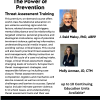Understanding Nonverbal Communications (Continuing Education Hours / Units) (3 hrs)
This unique ninety-minute, virtual presentation takes a fresh look at what we know about nonverbal communications and how they can be used in a professional, clinical or personal setting. The training focuses on those human behaviors that professionals must recognize which have a high reliability and are useful in assessing others. It will also provide a roadmap for conducting better, more empathic interviews and interpersonal communication.
Taught by noted spy catcher, Joe Navarro, the training exposes behaviors (some often ignored) that are useful in understanding the feelings, thoughts, desires, intentions, preferences, fears, and concerns of others. It will examine each area of the body that may be helpful in decoding the true thoughts and emotions of others. Gestures, facial expressions and body movement will be examined within their context for meaning. Additionally, the workshop will focus on other nonverbals, including the tone of voice and cadence of speech which have been shown to establish greater rapport and trust.
The workshop will also identify those nonverbals which do not have clear meaning and from which behavior is often misinterpreted. The training will also explore the limits of nonverbals, including the danger of trying to use nonverbal communications to detect deception. This program will be of great value to mental health professionals, law enforcement/security, corporate, sales and a variety of other professions.
Want something more in-depth? Check out Joe’s Body Language Academy (www.jnbodylanguageacademy.com). There you will find a 60 hour program, complete with CE’s. Better yet, get a solid introduction to nonverbal communication through this program and then go for the more in-depth program.
Workshop Content:
What are nonverbals and why are they so important.
Which areas of the body are more honest than others. Why the feet are the most honest part of the body.
The fifteen most accurate behaviors that reveal issues, concerns, dislike, disdain, or some form of psychological discomfort.
Myths about nonverbals as they relate to deception and eye behavior.
How we can use nonverbals to convey empathy.
How nonverbals encompass more than body language and what that means for influencing others.
How to assess properly for the spatial needs of others.
Behaviors that alert us to serious issues between couples.
What are some best practices for professionals in virtual environment.
Nonverbal mistakes to avoid.
Workshop Objectives:
Identify three areas of the body where nonverbals are most honest
Describe how to use nonverbals to convey empathy
Identify five behaviors that convey discomfort
Demonstrate two behaviors that may alert us to serious issues between a couple
List three practices that professionals should use in a virtual environment
Describe the most common myths regarding nonverbals as they relate to detecting deception
Continuing Education Credits: 3hrs
Additional information
| Product Options | On Demand Recording $19.99 |
|---|










